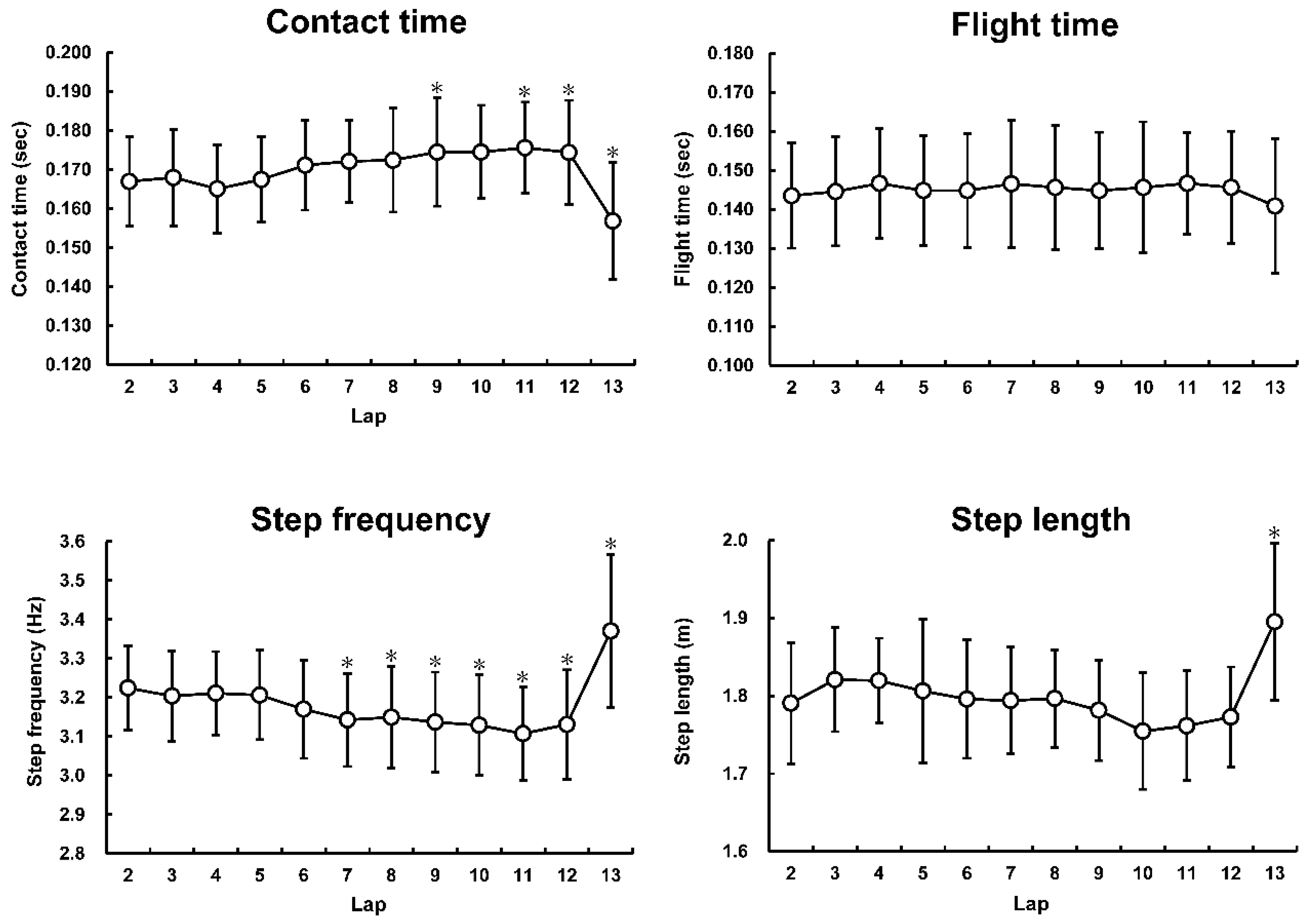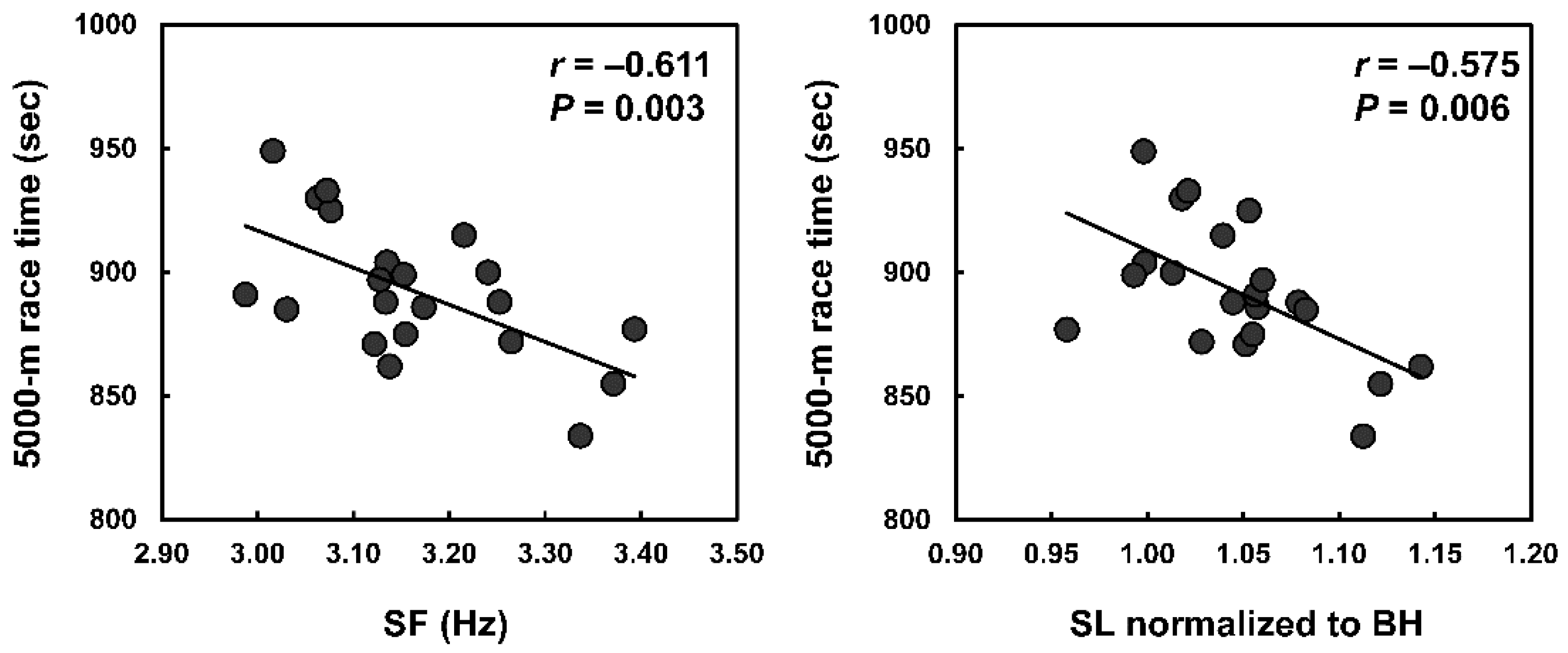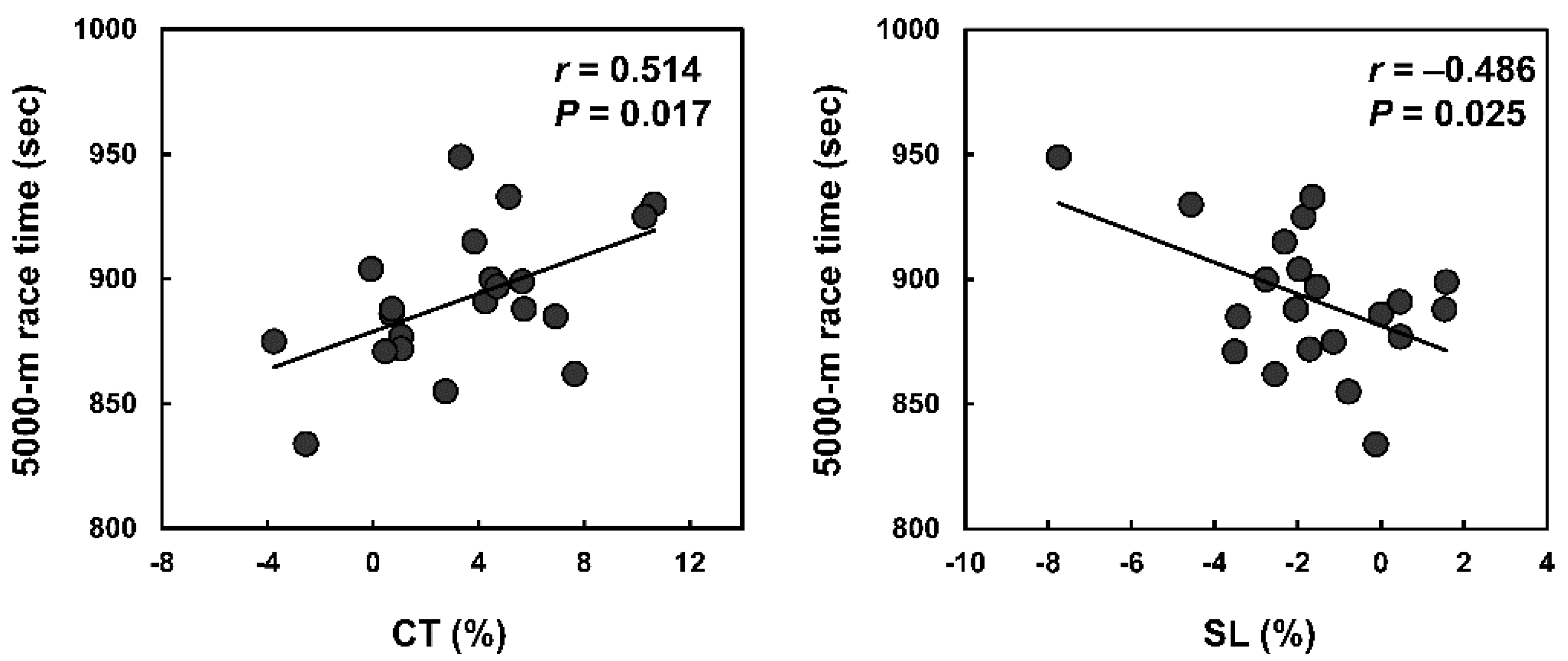Relationship between Step Characteristics and Race Performance during 5000-m Race
Abstract
:1. Introduction
2. Materials and Methods
2.1. Participants
2.2. Data Collection
2.3. Data Analysis
2.4. Statistical Analysis
3. Results
4. Discussion
5. Conclusions
Author Contributions
Funding
Institutional Review Board Statement
Informed Consent Statement
Data Availability Statement
Acknowledgments
Conflicts of Interest
References
- Barenes, K.R.; Kilding, A.E. Running economy: Measurement, norms, and determining factors. Sports Med. Open 2015, 1, 8. [Google Scholar] [CrossRef] [Green Version]
- Folland, J.P.; Allen, S.J.; Black, M.I.; Handsaker, J.C.; Forrester, S.E. Running technique is an important component of running economy and performance. Med. Sci. Sports Exerc. 2017, 49, 1412–1423. [Google Scholar] [CrossRef] [Green Version]
- Saunders, P.U.; Pyne, D.B.; Telford, R.D.; Hawley, J.A. Factors affecting running economy in trained distance runners. Sports Med. 2004, 34, 465–485. [Google Scholar] [CrossRef]
- Tartaruga, M.P.; Brisswalter, J.; Peyré-Tartaruga, L.A.; Avila, A.O.; Alberton, C.L.; Coertjens, M.; Cadore, E.L.; Tiggemann, C.L.; Silva, E.M.; Kruel, L.F. The relationship between running economy and biomechanical variables in distance runners. Res. Q. Exerc. Sport 2012, 83, 367–375. [Google Scholar] [CrossRef]
- Ueno, H.; Suga, T.; Takao, K.; Tanaka, T.; Misaki, J.; Miyake, Y.; Nagano, A.; Isaka, T. Association between forefoot bone length and performance in male endurance runners. Int. J. Sports Med. 2018, 39, 275–281. [Google Scholar] [CrossRef]
- Ueno, H.; Suga, T.; Takao, K.; Tanaka, T.; Misaki, J.; Miyake, Y.; Nagano, A.; Isaka, T. Relationship between Achilles tendon length and running performance in well-trained male endurance runners. Scand. J. Med. Sci. Sports 2018, 28, 446–451. [Google Scholar] [CrossRef]
- Ueno, H.; Suga, T.; Takao, K.; Tanaka, T.; Misaki, J.; Miyake, Y.; Nagano, A.; Isaka, T. Potential relationship between passive plantar flexor stiffness and running performance. Int. J. Sports Med. 2018, 39, 204–209. [Google Scholar] [CrossRef]
- Brughelli, M.; Cronin, J.; Chaouachi, A. Effects of running velocity on running kinetics and kinematics. J. Strength Cond. Res. 2011, 25, 933–939. [Google Scholar] [CrossRef] [PubMed] [Green Version]
- Nummela, A.; Keränen, T.; Mikkelsson, L.O. Factors related to top running speed and economy. Int. J. Sports Med. 2007, 28, 655–661. [Google Scholar] [CrossRef] [PubMed]
- Weyand, P.G.; Sternlight, D.B.; Bellizzi, M.J.; Wright, S. Faster top running speeds are achieved with greater ground forces not more rapid leg movements. J. Appl. Physiol. 2000, 89, 1991–1999. [Google Scholar] [CrossRef] [PubMed] [Green Version]
- Alexander, R.M. Stride length and speed for adults, children, and fossil hominids. Am. J. Phys. Anthrop. 1984, 63, 23–27. [Google Scholar] [CrossRef]
- Cavanagh, P.R.; Kram, R. Stride length in distance running: Velocity, body dimensions, and added mass effects. Med. Sci. Sports Exerc. 1989, 21, 467–479. [Google Scholar] [CrossRef]
- Kunimasa, Y.; Sano, K.; Oda, T.; Nicol, C.; Komi, P.V.; Locatelli, E.; Ito, A.; Ishikawa, M. Specific muscle-tendon architecture in elite Kenyan distance runners. Scand. J. Med. Sci. Sports 2014, 24, e269–e274. [Google Scholar] [CrossRef] [PubMed]
- Lucia, A.; Esteve-Lanao, J.; Oliván, J.; Gómez-Gallego, F.; San Juan, A.F.; Santiago, C.; Pérez, M.; Chamorro-Viña, C.; Foster, C. Physiological characteristics of the best Eritrean runners-exceptional running economy. Appl. Physiol. Nutr. Metab. 2006, 31, 530–540. [Google Scholar] [CrossRef]
- Mooses, M.; Mooses, K.; Haile, D.W.; Durussel, J.; Kaasik, P.; Pitsiladis, Y.P. Dissociation between running economy and running performance in elite Kenyan distance runners. J. Sports Sci. 2015, 33, 136–144. [Google Scholar] [CrossRef] [PubMed]
- Ueno, H.; Suga, T.; Takao, K.; Miyake, Y.; Terada, M.; Nagano, A.; Isaka, T. The potential relationship between leg bone length and running performance in well-trained endurance runners. J. Hum. Kinet. 2019, 70, 165–172. [Google Scholar] [CrossRef] [Green Version]
- Girard, O.; Millet, G.P.; Micallef, J.P.; Racinais, S. Alteration in neuromuscular function after a 5 km running time trial. Eur. J. Appl. Physiol. 2012, 112, 2323–2330. [Google Scholar] [CrossRef]
- Nummela, A.T.; Heath, K.A.; Paavolainen, L.M.; Lambert, M.I.; St Clair Gibson, A.; Rusko, H.K.; Noakes, T.D. Fatigue during a 5-km running time trial. Int. J. Sports Med. 2008, 29, 738–745. [Google Scholar] [CrossRef]
- Winter, S.; Gordon, S.; Watt, K. Effects of fatigue on kinematics and kinetics during overground running: A systematic review. J. Sports Med. Phys. Fitness 2017, 57, 887–899. [Google Scholar] [CrossRef]
- Heiderscheit, B.C.; Chumanov, E.S.; Michalski, M.P.; Wille, C.M.; Ryan, M.B. Effects of step rate manipulation on joint mechanics during running. Med. Sci. Sports Exerc. 2011, 43, 296–302. [Google Scholar] [CrossRef] [Green Version]
- Girard, O.; Millet, G.P.; Slawinski, J.; Racinais, S.; Micallef, J.P. Changes in running mechanics and spring-mass behaviour during a 5-km time trial. Int. J. Sports Med. 2013, 34, 832–840. [Google Scholar] [CrossRef] [PubMed]
- Elliot, B.; Ackland, T. Biomechanical effects of fatigue on 10,000 m running technique. Res. Q. Exerc. Sport 1981, 52, 160–166. [Google Scholar] [CrossRef]
- Austin, C.L.; Hokanson, J.F.; McGinnis, P.M.; Patrick, S. The relationship between running power and running economy in well-trained distance runners. Sports 2018, 6, 142. [Google Scholar] [CrossRef] [Green Version]
- Hasegawa, H.; Yamauchi, T.; Kraemer, W.J. Foot strike patterns of runners at the 15-km point during an elite-level half marathon. J. Strength Cond. Res. 2007, 21, 888–893. [Google Scholar] [PubMed]
- Hayes, P.; Caplan, N. Foot strike patterns and ground contact times during high-calibre middle-distance races. J. Sports Sci. 2012, 30, 1275–1283. [Google Scholar] [CrossRef]
- Giovanelli, N.; Taboga, P.; Lazzer, S. Changes in running mechanics during a 6-hour running race. Int. J. Sports Physiol. Perform. 2017, 12, 642–647. [Google Scholar] [CrossRef] [PubMed]
- González-Frutos, P.; Veiga, S.; Mallo, J.; Navarro, E. Spatiotemporal comparisons between elite and high-level 60 m hurdlers. Front. Psychol. 2019, 10, 2525. [Google Scholar] [CrossRef]
- Ozaki, Y.; Ueda, T.; Fukuda, T.; Inai, T.; Kido, E.; Narisako, D. Regulation of stride length during the approach run in the 400-M hurdles. J. Hum. Kinet. 2019, 69, 59–67. [Google Scholar] [CrossRef] [PubMed] [Green Version]
- García-Pinillos, F.; Jerez-Mayorga, D.; Latorre-Román, P.Á.; Ramirez-Campillo, R.; Sanz-López, F.; Roche-Seruendo, L.E. How do amateur endurance runners alter spatiotemporal parameters and step variability as running velocity increases? a sex comparison. J. Hum. Kinet. 2020, 72, 39–49. [Google Scholar] [CrossRef] [Green Version]
- Cohen, J. A power primer. Psychol. Bull. 1992, 112, 155–159. [Google Scholar] [CrossRef]
- Hamill, J.; Derrick, T.R.; Holt, K.G. Shock attenuation and stride frequency during running. Hum. Mov. Sci. 1995, 14, 45–60. [Google Scholar] [CrossRef]
- Hanley, B.; Smith, L.C.; Bissas, A. Kinematic variations due to changes in pace during men’s and women’s 5 km road running. Int. J. Sports Sci. Coach. 2011, 6, 243–252. [Google Scholar] [CrossRef]
- Komi, P.V. Stretch-shortening cycle: A powerful model to study normal and fatigued muscle. J. Biomech. 2000, 33, 1197–1206. [Google Scholar] [CrossRef] [Green Version]
- De Koning, J.J.; Foster, C.; Bakkum, A.; Kloppenburg, S.; Thiel, C.; Joseph, T.; Cohen, J.; Porcari, J.P. Regulation of pacing strategy during athletic competition. PLoS ONE 2011, 6, e15863. [Google Scholar] [CrossRef]
- Tucker, R.; Lambert, M.I.; Noakes, T.D. An analysis of pacing strategies during men’s world-record performances in track athletics. Int. J. Sports Physiol. Perform. 2006, 1, 233–245. [Google Scholar] [CrossRef] [Green Version]
- Myrkos, A.; Smilios, I.; Kokkinou, E.M.; Rousopoulos, E.; Douda, H. Physiological and race pace characteristics of medium and low-level Athens marathon runners. Sports 2020, 8, 116. [Google Scholar] [CrossRef] [PubMed]
- Santos-Lozano, A.; Collado, P.S.; Foster, C.; Lucia, A.; Garatachea, N. Influence of sex and level on marathon pacing strategy. Insights from the New York City race. Int. J. Sports Med. 2014, 35, 933–938. [Google Scholar] [CrossRef]
- Esteve-Lanao, J.; Rhea, M.R.; Fleck, S.J.; Lucia, A. Running-specific, periodized strength training attenuates loss of stride length during intense endurance running. J. Strength Cond. Res. 2008, 22, 1176–1183. [Google Scholar] [CrossRef] [Green Version]
- Gómez-Molina, J.; Ogueta-Alday, A.; Camara, J.; Stickley, C.; García-López, J. Effect of 8 weeks of concurrent plyometric and running training on spatiotemporal and physiological variables of novice runners. Eur. J. Sport Sci. 2018, 18, 162–169. [Google Scholar] [CrossRef]
- Quinn, T.J.; Dempsey, S.L.; LaRoche, D.P.; Mackenzie, A.M.; Cook, S.B. Step Frequency training improves running economy in well-trained female runners. J. Strength Cond. Res. 2019, 35, 2511–2517. [Google Scholar] [CrossRef] [PubMed]




| Step Characteristics | Mean ± SD | Range |
|---|---|---|
| Average of all laps | ||
| CT, s | 0.170 ± 0.011 | 0.152–0.197 |
| FT, s | 0.145 ± 0.014 | 0.112–0.179 |
| SF, Hz | 3.16 ± 0.11 | 2.99–3.39 |
| SL, m | 1.79 ± 0.06 | 1.69–1.89 |
| SL normalized to BH | 1.05 ± 0.04 | 0.96–1.14 |
| Average of the first half | ||
| CT, s | 0.168 ± 0.010 | 0.150–0.193 |
| FT, s | 0.145 ± 0.014 | 0.114–0.175 |
| SF, Hz | 3.19 ± 0.11 | 3.04–3.42 |
| SL, m | 1.80 ± 0.06 | 1.68–1.92 |
| SL normalized to BH | 1.06 ± 0.05 | 0.96–1.14 |
| Average of the second half | ||
| CT, s | 0.174 ± 0.012 | 0.154–0.202 |
| FT, s | 0.146 ± 0.015 | 0.109–0.183 |
| SF, Hz | 3.13 ± 0.12 | 2.92–3.36 |
| SL, m | 1.77 ± 0.06 | 1.66–1.86 |
| SL normalized to BH | 1.04 ± 0.05 | 0.95–1.13 |
| Final lap | ||
| CT, s | 0.158 ± 0.017 | 0.133–0.198 |
| FT, s | 0.141 ± 0.018 | 0.100–0.164 |
| SF, Hz | 3.37 ± 0.20 | 3.04–3.81 |
| SL, m | 1.90 ± 0.10 | 1.69–2.11 |
| SL normalized to BH | 1.11 ± 0.06 | 0.97–1.21 |
| Per cent change | ||
| CT, % | 3.47 ± 3.75 | −3.76–10.65 |
| FT, % | 0.36 ± 4.00 | −7.48–8.95 |
| SF, % | −1.96 ± 1.63 | −4.73–0.63 |
| SL, % | −1.70 ± 2.13 | −7.75–1.58 |
Publisher’s Note: MDPI stays neutral with regard to jurisdictional claims in published maps and institutional affiliations. |
© 2021 by the authors. Licensee MDPI, Basel, Switzerland. This article is an open access article distributed under the terms and conditions of the Creative Commons Attribution (CC BY) license (https://creativecommons.org/licenses/by/4.0/).
Share and Cite
Ueno, H.; Nakazawa, S.; Takeuchi, Y.; Sugita, M. Relationship between Step Characteristics and Race Performance during 5000-m Race. Sports 2021, 9, 131. https://doi.org/10.3390/sports9090131
Ueno H, Nakazawa S, Takeuchi Y, Sugita M. Relationship between Step Characteristics and Race Performance during 5000-m Race. Sports. 2021; 9(9):131. https://doi.org/10.3390/sports9090131
Chicago/Turabian StyleUeno, Hiromasa, Sho Nakazawa, Yohsuke Takeuchi, and Masaaki Sugita. 2021. "Relationship between Step Characteristics and Race Performance during 5000-m Race" Sports 9, no. 9: 131. https://doi.org/10.3390/sports9090131
APA StyleUeno, H., Nakazawa, S., Takeuchi, Y., & Sugita, M. (2021). Relationship between Step Characteristics and Race Performance during 5000-m Race. Sports, 9(9), 131. https://doi.org/10.3390/sports9090131





